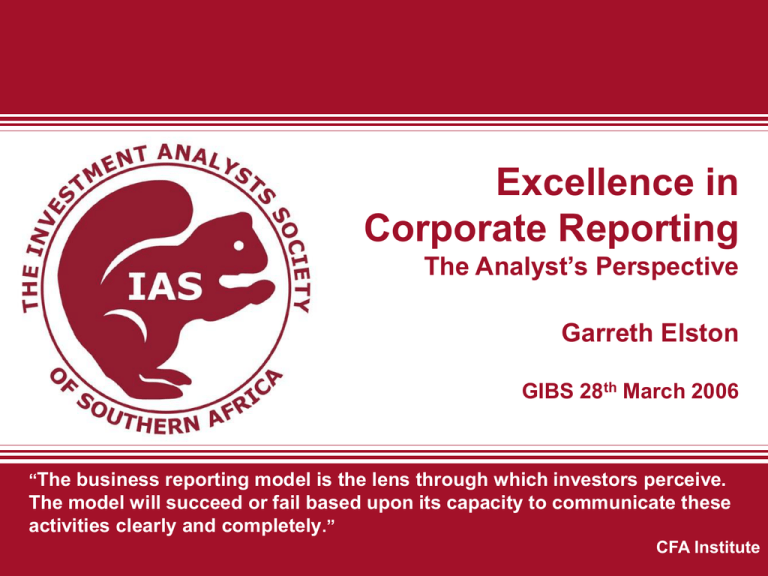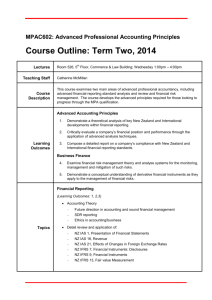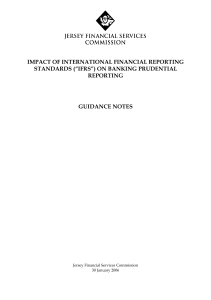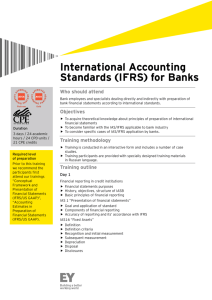IASSA Presentation 2006-03-28 GIBS
advertisement

Excellence in Corporate Reporting The Analyst’s Perspective Garreth Elston GIBS 28th March 2006 “The business reporting model is the lens through which investors perceive. The model will succeed or fail based upon its capacity to communicate these activities clearly and completely.” CFA Institute Alphabet Soup - Complexity Is Here to Stay • • • • • • • • • • • • • • • • • IFRS 1, (AC138) First-Time Adoption of international Financial Reporting Standards IFRS 10, Events After the Balance Sheet Date IFRS 32, (AC125) Financial Instruments: Disclosure and Presentation IFRS 33, Earnings Per Share IFRS 34, Interim Financial Reporting IFRS 35, Discontinuing Operations IFRS 36, (AC128) Impairment of Assets IFRS 37, Provisions, Contingent Liabilities, and Contingent Assets IFRS 38, Intangible Assets IFRS 39, Financial Instruments: Recognition and Measurement IFRS 39, Implementation Guidance: Questions and Answers IFRS 40, Investment Property IFRS 41, Agriculture IFRS 2 (AC139), Share-Based payments IFRS 3, (AC 140) Business Combinations (will replace AC 131) IFRS 4, (AC 141) Insurance Contracts IFRS 5 (AC 142) Non-current Assets Held for Sale and Discontinued Operations • • • • • • • • • • • • • • • • • IAS 1(AC 101) (revised): Presentation of Financial Statements IAS 2 (AC 108) (revised): Inventories IAS 8 (AC 103) (revised): Accounting Policies, Changes in Accounting Estimates and Errors IAS 10 (AC 107) (revised): Events after the Balance Sheet IAS 16 (AC 123) (revised): Property, Plant and Equipment IAS 17 (AC 105) (revised): Leases IAS 21 (AC 112) (revised): The Effects of Changes in Foreign Exchange Rates IAS 24 (AC 126) (revised): Related Party Disclosure IAS 27 (AC 132) (revised): Consolidated and Separate Financial Statement IAS 28 (AC 110) (revised): Investment in Associates IAS 31 (AC 119) (revised): Interests in Joint Ventures IAS 32 (AC 125) (revised): Financial Instruments: Disclosure and Presentation IAS 33 (AC 104) (revised): Earnings per Share IAS 36 (AC 128) (revised): Impairment of Assets IAS 38 (AC 129) (revised): Intangible Assets IAS 39 (AC 133) (revised): Financial Instruments: Recognition and Measurement IAS 40 (AC 137) (revised): Investment Property The Users of Corporate Reports Span the Investor Universe - Equity Analysts, Fund Managers, Regulators, Credit Analysts, Personal Investors… Investors' information needs come first • This concept is the foundation for fair and ethical financial markets, and a core tenet of the CFA Code of Ethics and Standards of Professional Conduct. Financial statements exist to help investors make informed investment decisions • Efforts to improve the quality of financial reporting must be considered first and foremost in light of what benefits those who use financial statements, not those who prepare them. Financial statements must be as unbiased and complete as possible • No one should be permitted to manage financial-reporting information to make companies appear more profitable than they really are. Financial statements must faithfully report economic reality. They must not be distorted. Quality And Clarity Are Vital • Investors’ ability to understand financial information is a function of how the information is communicated and not just the information itself. • Communicating in a way that is understandable to the investor is a fundamental responsibility of the managers who use the investor’s capital. • Information must be presented clearly, described in a way that is intended to communicate rather than confuse, and disclosed in sufficient detail to facilitate understanding by investors. Top Reporting Principles From The Global Analyst Community The company must be viewed from the perspective of a current investor in the company’s common equity: • Reasons for Importance: The current common shareowner (CCS) is the last to receive a share of the company’s net assets (that is, assets in excess of liabilities) and earnings. This means that the claims of all others must be fully satisfied before those of the CCS. Consequently, a CCS must have complete, accurate information about all other claims (including potential risk exposures and possible returns) to value his or her own investment. Fair value information is the only information relevant for financial decision making: • Reasons for Importance: Decisions about whether to purchase, sell, or hold investments are based upon the fair values of the investments and expectations about future changes in their fair values. Financial statements based on outdated historical costs are less useful for making such assessments. Source: CFA Institute’s Centre for Financial Market Integrity Top Reporting Principles From The Global Analyst Community Recognition and disclosure must be determined by the relevance of the information to investment decision making and not based upon measurement reliability alone. • Reasons for Importance: Financial information may be completely reliable if it is easily verifiable according to one or more criteria. But the information may not be relevant for financial decision making. An example is the purchase by a company of a major manufacturing facility 30 years ago for which the bill of sale is available to support the recorded cost. All economic transactions and events should be completely and accurately recognised as they occur in the financial statements. • Reasons for Importance: The purpose of financial reporting is to convey the economic position of the company and changes in that position to investors. Reporting methods that omit or fail to reflect the economic essence of events and transactions as they occur do not achieve the purpose of financial reporting. Source: CFA Institute’s Centre for Financial Market Integrity Top Reporting Principles From The Global Analyst Community Financial reporting must be neutral. • Reasons for Importance: Reporting of economic transactions and events should not be influenced by the outcomes of the financial reporting or the effects that the reporting may have on one or more interests. For example, the recent stock options expensing debate. All costs of production, including employee compensation, must be reported fairly, completely, and accurately. Changes affecting each of the financial statements must be reported and explained on a disaggregated basis. • Reasons for Importance: Aggregation of information with different economic attributes, different measurement bases, different trends, and from very different operations results in substantial loss of information. Indeed, the information lost is essential to investors’ understanding of a company’s financial position, changes in that position, and the implications for valuation of investments. Source: CFA Institute’s Centre for Financial Market Integrity Top Reporting Principles From The Global Analyst Community • Disclosures must provide all the additional information investors require to understand the items recognised in the financial statements, their measurement properties, and risk exposures. • Reasons for Importance: If investors are to understand the numbers reported in the financial statements, they must have sufficient supplementary disclosures to evaluate the numbers. Such disclosures can include, for example: – – – – – – • Financial reporting methods used, Models used for estimation and measurement, Assumptions used, Sensitivity analyses of point estimates, Information about risk exposures, Information explaining why changes in important items have occurred, and a host of other important items. In short, the statements are not interpretable without them. Disclosures should be regarded as being as important to investors’ assessments as the recognition and measurement in the statements. Source: CFA Institute’s Centre for Financial Market Integrity Reporting Changes in Financial Statements Communication Principles Communicate Early: • Communicate the likely impact of any changes prior to the release of the live data, rather than releasing it for the first time on the same day. Explain the timetable and what information can be expected when. Communicate Directly: • Keep formal announcements, presentations and explanatory documents separate from other announcements so there is no confusion with the underlying trading position. Running a specific briefing session for analysts is useful as the feedback will enable you to check that the communication is clear. Source: UK Investor Relations Society Reporting Changes in Financial Statements Communication Principles Communicate Comprehensively • All changes need to be communicated so don’t be afraid to go into depth. Go through the Income Statement, Cash flow and Balance Sheet line by line if necessary, explaining the change and its effect. Full descriptions will still need to be given in the interims and annual accounts to ensure all shareholders have been fully briefed. These should include any relevant underlying assumptions. Manage Expectations • Monitor changes in analysts’ forecasts to pick up any inconsistencies and track the basis for their forecasts. Some may take different positions, particularly if the changes in standards are still being firmed up during the year. This may mean consensus numbers are unreliable for a period. Source: UK Investor Relations Society Further Reading The CFA Institute’s Centre for Financial Market Integrity has developed two comprehensive manuals for practitioners interested in guidelines to assisting in achieving best practice in Excellence in Corporate Reporting, these are: • A COMPREHENSIVE BUSINESS REPORTING MODEL: Financial Reporting for Investors • THE CORPORATE GOVERNANCE OF LISTED COMPANIES: A Manual for Investors Both of these are available on request from: garreth.elston@gmail.com or from http://www.cfainstitute.org/cfacentre/








